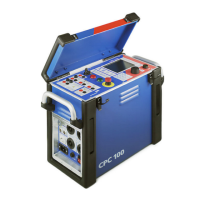CPC 100 V 3.20
Current Transformer - 9
The SV-Ratio test card is mainly used to check the ratio between the output current or voltage
and the input current or voltage of the selected merging unit channel according to the IEC 61850
standard. In addition, the SV-Ratio card is also used to determine the polarity of the signal,
whereas the CPC 100 serves as the signal source. The merging units generate the input
voltages or currents.
The CPC 100 test system performs closed-loop testing whereby a test signal is injected on the
primary side of the current/voltage sensors. The Merging Unit (MU) converts the sensor output
into an SV stream which is published to the substation network. The CPC 100 then reads the
data back from the network in order to perform a variety of different tests.
The CPC 100 transforms the sampled points to the spectral function of the signal. This Fourier-
transformed sampled values signal is filtered with a special Hann window to only retrieve the
“signal” at the selected frequency. This allows frequency-selective measurements to be
performed on SV streams and thereby the noise is suppressed.
The SV-Ratio test card can be accessed from CT, VT or Others.
The following tests can be performed:
• Ratio and polarity
• Automatic MU detection
• Frequency-selective current/voltage measurement
• Noise level measurement
• Magnitude response of the signal processing chain (15 to 400 Hz)
Block diagram of a typical measurement setup:
CPC 100
(SV-Ratio)
Primary side
analog
digital
digital
Ethernet
IRT**
Switch
Optical fiber
Substation
Network
MU*
CT/VT
* If the MU has an Ethernet output, no IRT switch is required.
** IRT Switch: Industrial Real-Time Switch
Note: The SV-Ratio test card can be used both for current transformers and voltage
transformers alike. Therefore, the description refers to currents and voltages.
output
input

